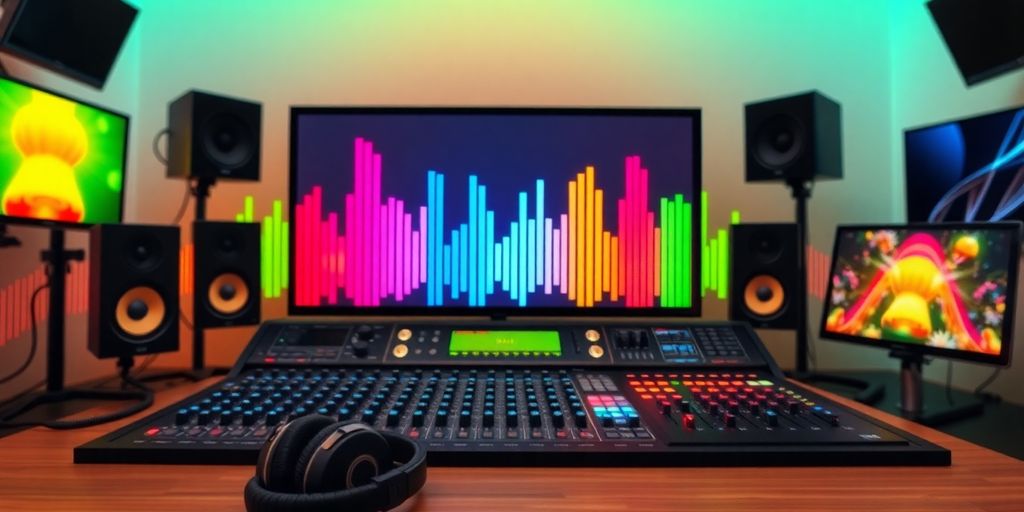
Finding the right music for news broadcasts can really change the mood and impact of your stories. Whether you’re reporting on serious events or lighter news, the right track sets the tone and grabs viewers’ attention. This article will help you explore how to choose the best music for news, highlighting genres, benefits of royalty-free options, and tips for integrating music into your broadcasts.
Key Takeaways
- Choose music that matches the tone of your news content.
- Know your audience to select the right style of music.
- Royalty-free music is a budget-friendly option for broadcasters.
- Explore various music libraries and independent composers for unique tracks.
- Timing and volume are key when integrating music into your news segments.
Choosing The Right Music For News
Understanding The Tone
It’s important to get the tone right. The music you pick should match the mood of the news story. A light, upbeat tune probably isn’t the best choice for a serious report, and vice versa. Think about what feeling you want viewers to have. Is it urgency? Hope? Concern? The music should support that.
Identifying Your Audience
Who are you talking to? Knowing your audience is key. A younger audience might respond well to modern electronic sounds, while an older audience might prefer something more classical. Consider the demographics of your viewers and choose music that appeals to them. It’s all about making a connection.
Matching Music To Content
This is where it all comes together. The music needs to fit the story. If you’re reporting on a tech breakthrough, maybe some royalty free audio tracks with a futuristic vibe would work. For a human-interest piece, something more emotional and gentle might be better. It’s about finding the perfect harmony between the visuals, the words, and the music.
Think of music as another layer of storytelling. It’s not just background noise; it’s a tool to help you communicate the message more effectively. When you get it right, it can really make a difference in how people perceive the news.
Popular Genres For News Music
When you’re picking music for news broadcasts, it’s good to know what styles usually work well. It’s not just about picking something that sounds "serious"; it’s about finding music that fits the story and keeps people watching. Let’s look at some popular choices.
Classical Influences
Classical music is a long-time favorite for news. Its inherent sense of importance and history makes it a natural fit. Think about how often you hear orchestral pieces or piano melodies during serious news segments. It’s not just about sounding fancy; it’s about adding weight to the story. A simple piano piece can add a touch of gravitas. String sections can build tension during developing stories. It’s a reliable choice, but you have to be careful not to sound too stuffy or old-fashioned.
Modern Electronic Sounds
Electronic music might seem like an odd choice, but it’s becoming more common. It can create a sense of urgency and modernity. Think about using synth pads to create a background atmosphere or using electronic percussion to add a sense of pace. It’s all about finding the right balance. You don’t want to distract from the news, but you do want to keep things interesting. You can find royalty free music that fits this style.
Cinematic Scores
Cinematic scores are designed to evoke emotion, and that’s exactly what you want in news sometimes. These scores often feature sweeping orchestral arrangements, dramatic percussion, and soaring melodies. They can be great for highlighting important moments or adding a sense of drama to a story. The key is to use them sparingly. Too much drama can feel manipulative, but just enough can really drive home the importance of a story.
News music doesn’t have to be boring. It can be a powerful tool for storytelling. The right music can set the tone, emphasize key moments, and engage viewers. It’s all about finding the right balance between information and emotion.
Benefits Of Using Royalty-Free Music
Cost-Effective Solutions
Let’s be real, budgets are always tight, especially in news. Royalty-free music offers a way to get high-quality tracks without breaking the bank. Instead of paying every time a song is played, you pay a one-time fee or subscription. This can save a ton of money, especially for smaller news outlets or independent journalists. Think of it as buying the music outright, but without all the complicated licensing stuff.
Legal Peace Of Mind
Navigating copyright laws can feel like walking through a minefield. With royalty-free music, you get a license that spells out exactly how you can use the music. This means you don’t have to worry about getting sued for copyright infringement. It’s a huge relief to know you’re covered, especially when you’re dealing with time-sensitive news content. You can focus on the story, not the legal paperwork. It’s all about legal peace of mind.
Diverse Selection
Gone are the days when royalty-free meant cheesy elevator music. Today, there’s a massive library of tracks available, covering pretty much every genre and style you can imagine. Whether you need something dramatic for a breaking news story or something upbeat for a feel-good piece, you can find it. The variety lets you tailor the music to the specific tone and message of each news segment. It’s like having a whole orchestra at your fingertips.
Using royalty-free music is a smart move for news organizations. It keeps costs down, avoids legal headaches, and provides a wide range of musical options. It’s a win-win-win situation.
Where To Find Quality Music For News

Finding the right music for your news broadcast can feel like searching for a needle in a haystack. But don’t worry, there are several places you can turn to for high-quality tracks that won’t break the bank.
Top Royalty-Free Music Libraries
These libraries are a great starting point. They usually have a wide selection of music, and you can filter by genre, mood, and tempo to find exactly what you need. Many offer subscription plans that give you unlimited access to their entire catalog.
- Artlist
- Epidemic Sound
- PremiumBeat
These platforms often have curated playlists specifically for news and current affairs, which can save you a lot of time. Make sure to check the licensing terms carefully to ensure the music is suitable for your intended use. You can find music licensing options that fit your needs.
Online Marketplaces
Online marketplaces are another option. These sites host music from various independent composers, giving you a more diverse range of styles to choose from. You can often find unique and interesting tracks that you wouldn’t find in the larger libraries.
- AudioJungle
- Pond5
- Creative Market
The advantage of marketplaces is that you can often purchase individual tracks, which can be more cost-effective if you only need a few songs. However, licensing terms can vary greatly, so be sure to read the fine print before making a purchase.
Independent Composers
Working directly with independent composers can be a fantastic way to get truly unique music tailored to your specific needs. It might take more effort to find and vet composers, but the results can be well worth it. Plus, you’re supporting independent artists!
- Benefits of direct collaboration:
- Custom music creation
- Exclusive rights (potentially)
- Direct communication and feedback
Finding composers can be done through online platforms like Fiverr or Upwork, or by reaching out to music schools and universities. Be sure to listen to their previous work and discuss your project in detail to ensure they understand your vision. Consider exploring copyright-free music from independent artists.
Tips For Integrating Music Into News Broadcasts

Timing And Placement
Getting the timing right is super important. You don’t want the music to clash with the anchor’s voice or distract from important information. Think of music as a support, not the main event. A good rule of thumb is to use music during transitions, lead-ins, or when showing visuals that don’t require narration. For example, a somber piece might play under footage of a disaster scene, or an upbeat track could introduce a segment on local achievements.
Volume Control
Volume is key. The music should be audible, but never overpowering. It’s there to add to the story, not drown it out. A good mix ensures that viewers can clearly hear the news anchor and any sound coming from video clips. It’s a balancing act, and it might take some practice to get it just right.
- Test the audio levels before going live.
- Use a compressor to even out the dynamics.
- Pay attention to the frequency range to avoid muddiness.
Creating Emotional Impact
Music has the power to make people feel things. Choosing the right track can really drive home the emotional core of a news story. A hopeful melody can underscore a story about recovery, while a more serious piece can highlight the gravity of a difficult situation. Think about what you want the audience to feel, and then pick music that matches that feeling. Consider using royalty-free news music to enhance radio segments.
Music can be a powerful tool in news broadcasting, but it needs to be used thoughtfully. Overdoing it can make the broadcast seem manipulative or insincere. The goal is to enhance the story, not overshadow it.
The Role Of Music In Enhancing News Stories
Setting The Mood
Music is super important for setting the mood in news stories. Think about it: a somber piano piece during a report on a tragedy, or an upbeat track for a story about a local hero. The right music can instantly tell the viewer how to feel. It’s like a shortcut to their emotions, making the story more impactful. It’s not just background noise; it’s a tool to guide the audience’s emotional journey. You can find great royalty-free news music to set the perfect tone.
Emphasizing Key Moments
Music can really highlight those crucial moments in a news story. A well-placed musical cue can make a big difference. It’s all about timing. A crescendo right before a major announcement, or a sudden silence to emphasize a shocking revelation. These musical cues aren’t just decoration; they’re there to make sure the audience feels the weight of the moment. It’s a subtle art, but when done right, it’s incredibly effective.
Engaging Viewers
Good music keeps people watching. It’s that simple. A catchy theme or a well-chosen background track can make a news segment more appealing. It adds a layer of polish and professionalism that viewers subconsciously appreciate. It’s about creating an experience that’s both informative and engaging. Think of it like this: would you rather watch a news report with dull silence, or one with music that draws you in? The answer is pretty obvious. Music helps to create a multi-sensory experience, making the content more memorable.
Trends In News Music Composition
Use Of Ambient Sounds
Ambient sounds are becoming more common in news music. Think subtle soundscapes that create a sense of atmosphere without being distracting. It’s all about adding depth and texture. For example, you might hear a low hum, gentle wind noises, or even the faint sound of city traffic. These sounds help to create a sense of realism and can make the news feel more immersive. It’s a move away from overly dramatic scores and towards something more understated and sophisticated. You can find a diverse selection at MusicRevolution.
Incorporating Cultural Elements
News music is starting to reflect a wider range of cultural influences. This means incorporating instruments, rhythms, and melodies from different parts of the world. It’s a way to connect with a more diverse audience and to add a unique flavor to news broadcasts. However, it’s important to do this respectfully and authentically, avoiding stereotypes or cultural appropriation. The goal is to enhance the story, not distract from it.
Innovative Instrumentation
We’re seeing some really interesting stuff happening with the instruments used in news music. Composers are experimenting with unusual combinations and sounds. Think about blending electronic elements with traditional orchestral instruments, or using unconventional instruments to create unique textures. This can help to create a more modern and engaging sound that stands out from the crowd.
The shift towards innovative instrumentation reflects a broader trend in music production, where composers are constantly seeking new ways to capture attention and evoke emotion. This experimentation can lead to some truly groundbreaking and memorable news themes.
Here’s a quick look at some of the instruments gaining popularity:
- Modular synthesizers
- Prepared piano
- World percussion instruments
- Processed field recordings
Wrapping It Up
In the end, picking the right music for your news broadcast can really make a difference. Royalty-free tracks are a great way to add that extra touch without breaking the bank. They help set the mood and keep your audience engaged. Plus, with so many options out there, you can find something that fits your style perfectly. So, whether you’re working on a serious report or a light-hearted segment, don’t overlook the power of music. It can elevate your content and make your broadcast stand out. Happy hunting for those perfect tracks!
Frequently Asked Questions
What types of music are often used in news broadcasts?
News broadcasts usually use music that is serious and attention-grabbing. This can include orchestral music, electronic beats, and other styles that fit the news theme.
Does news music always have to be intense?
Not necessarily! While some news music is dramatic, it can also be calm or neutral, depending on the story being told.
How can I creatively use royalty-free music in my news segments?
You can use royalty-free music to set the mood, highlight important moments, or create transitions between different news stories.
Where can I find royalty-free music for my news reports?
You can find royalty-free music on various websites that offer music libraries, online marketplaces, or by hiring independent composers.
What are the advantages of using royalty-free music?
Using royalty-free music can save you money, reduce legal worries, and give you a wide variety of music to choose from.
How can I effectively add music to my news broadcasts?
To effectively add music, consider the timing, keep the volume balanced, and use music to enhance the emotional impact of your stories.





